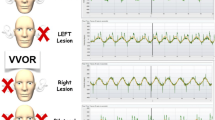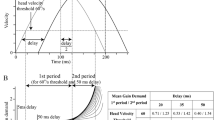Abstract
Accurate performance by the vestibulo-ocular reflex (VOR) is necessary to stabilize visual fixation during head movements. VOR performance is severely affected by peripheral vestibular damage; after one horizontal semicircular canal is plugged, the horizontal VOR is asymmetric and its amplitude is reduced. The VOR recovers partially. We investigated the limits of recovery by measuring the VOR’s response to ipsilesional and contralesional rotation after unilateral peripheral damage in cats. We found that the VOR’s response to rotation at high frequencies remained asymmetric after recovery was complete. When the stimulus was a pulse of head velocity comprising a dynamic overshoot followed by a plateau, gain was partially restored and symmetry completely restored within 30 days after the plug, but only for the plateau response. The overshoot in eye velocity remained asymmetric. The asymmetry was independent of stimulus velocity throughout the known linear velocity range of primary vestibular afferents. Sinusoidal rotation at 0.05–8 Hz revealed that, within this range, the persistent asymmetry was significant only at frequencies above 2 Hz. Asymmetry was independent of the peak head acceleration over the range of 50–500°/s2. When both horizontal canals were plugged, a small residual VOR was observed, suggesting residual signal transduction by plugged semicircular canals. However, transduction by plugged canals could not explain the enhancement of the VOR gain, at high frequencies, for rotation away from the plugged side compared with rotation toward the plug. Also, the high-frequency asymmetry was present after recovery from a unilateral labyrinthectomy. These results suggest that high-frequency asymmetry after unilateral damage is not due to residual function in the plugged canal. The findings are discussed in the context of a bilateral model of the VOR that includes central filtering.
Similar content being viewed by others
Author information
Authors and Affiliations
Additional information
Received: 21 January 1998 / Accepted: 1 October 1998
Rights and permissions
About this article
Cite this article
Broussard, D., Bhatia, J. & Jones, G. The dynamics of the vestibulo-ocular reflex after peripheral vestibular damage I. Frequency-dependent asymmetry. Exp Brain Res 125, 353–364 (1999). https://doi.org/10.1007/s002210050691
Issue Date:
DOI: https://doi.org/10.1007/s002210050691




